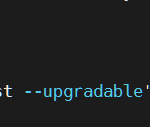Introduction
Temporary files are used to temporarily store data that the operating system needs temporarily during operation and will disappear when no longer needed. they will disappear on their own after reboot.
This command in Linux allows the user to make a temporary file or directory in the tmp folder. Now we’re gonna teach you to use the mktemp command in Linux.
The syntax of the mktemp command
The syntax:
$ mktemp [option] … [template]
For example:
$ mktemp
Output:
You have just created a temporary file in the tmp directory. And the filename is also generated automatically.
Creating a temporary directory
To do this. Let’s add the option -d into the command:
$ mktemp -d
Output:
Name the temporary file
If you want to name the temporary file, add more than 3 X’s at the end. For example:
$ mktemp newfileXXX
Output:
Or you can name the temporary directory:
$ mktemp -d newdicXXX
Output:
Adding the suffix
To do this. Let’s add the option –suffix into the command. For example:
$ mktemp newfileXXX --suffix ".txt"
Output:
Conclusion
We just taught you to use the mktemp command in Linux.
Thank you for referring!
Karim Buzdar holds a degree in telecommunication engineering and holds several sysadmin certifications including CCNA RS, SCP, and ACE. As an IT engineer and technical author, he writes for various websites.
Discover more from Ubuntu-Server.com
Subscribe to get the latest posts sent to your email.









